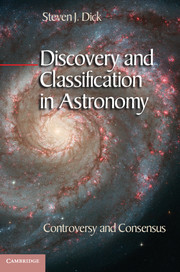Book contents
- Frontmatter
- Contents
- Preface
- Abbreviations
- Introduction The Natural History of the Heavens and the Natural History of Discovery
- Part I Entrée
- Part II Narratives of Discovery
- 2 Moons, Rings, and Asteroids
- 3 In Herschel’s Gardens
- 4 Dwarfs, Giants, and Planets (Again!)
- 5 Galaxies, Quasars, and Clusters
- Part III Patterns of Discovery
- Part IV Drivers of Discovery
- Part V The Synthesis of Discovery
- Appendix 1 Astronomy’s Three Kingdoms
- Appendix 2 Astronomical Discoveries and Their Extended Structure
- Notes
- Select Bibliographical Essay
- Glossary of Concepts Related to Discovery
- Index
3 - In Herschel’s Gardens
Nebulous Discoveries in the Realm of the Stars
from Part II - Narratives of Discovery
Published online by Cambridge University Press: 05 August 2013
- Frontmatter
- Contents
- Preface
- Abbreviations
- Introduction The Natural History of the Heavens and the Natural History of Discovery
- Part I Entrée
- Part II Narratives of Discovery
- 2 Moons, Rings, and Asteroids
- 3 In Herschel’s Gardens
- 4 Dwarfs, Giants, and Planets (Again!)
- 5 Galaxies, Quasars, and Clusters
- Part III Patterns of Discovery
- Part IV Drivers of Discovery
- Part V The Synthesis of Discovery
- Appendix 1 Astronomy’s Three Kingdoms
- Appendix 2 Astronomical Discoveries and Their Extended Structure
- Notes
- Select Bibliographical Essay
- Glossary of Concepts Related to Discovery
- Index
Summary
But what a field of novelty is here opened to our conceptions! A shining fluid, of a brightness sufficient to reach us from the remote regions of a star of the 8th, 9th, 10th, 11th or 12th magnitude, and of an extent so considerable as to take up 3, 4, 5, or 6 minutes in diameter! Perhaps it has been too hastily surmised that all milky nebulosity, of which there is so much in the heavens, is owing to starlight only.
William Herschel, 1791Here in dividing the different parts of which the sidereal heavens are composed into proper classes, I shall have to examine the nature of the various celestial objects that have been hitherto discovered, in order to arrange them in a manner most comfortable to their construction.
William Herschel, 1802If discovery in the realm of the planets was difficult, in the realm of the stars the problems were only multiplied. While Pluto, representing the outer edge of the solar system as it was known in 1930, was about forty times the distance of the Earth from the Sun (40 astronomical units, or 4 billion miles), the nearest star was 25 trillion miles, a factor of nearly 7000 times more distant. Put another way, rather than light minutes or light hours for the planets, the nearest stellar distances were measured in light-years, and the more distant ones in hundreds or thousands of light-years. Whereas a light beam from Pluto would take a few hours to travel to Earth, the nearest starlight (other than our own Sun!) would take 4.2 years. In terms of distance, astronomers studying the stars clearly entered a new realm in discovery and interpretation when it came to techniques of observation and methods of inference.
Astronomers at the time, however, knew little about the distances they were dealing with. The fixed stars of time immemorial notwithstanding, so-called sidereal astronomy did not become an important part of astronomy until the eighteenth century, when observers such as the French astronomers Nicholas-Louis de la Caille and Charles Messier focused on objects in the realm of the stars, and especially when William Herschel began using his newly constructed large telescopes in England. The Copernican theory implied vast stellar distances, but those distances remained unknown until 1838 with the first determinations of stellar parallax, and even then only the distances to the nearest stars could be measured. A few years earlier Auguste Comte famously highlighted the composition of the stars as the very prototype of a problem that could never be solved. But the development of spectroscopy in the 1850s and 1860s enabled just that, a stunning feat in the annals of human thought that unlocked the secrets of the sidereal realm – but only slowly and grudgingly.
- Type
- Chapter
- Information
- Discovery and Classification in AstronomyControversy and Consensus, pp. 63 - 90Publisher: Cambridge University PressPrint publication year: 2013



